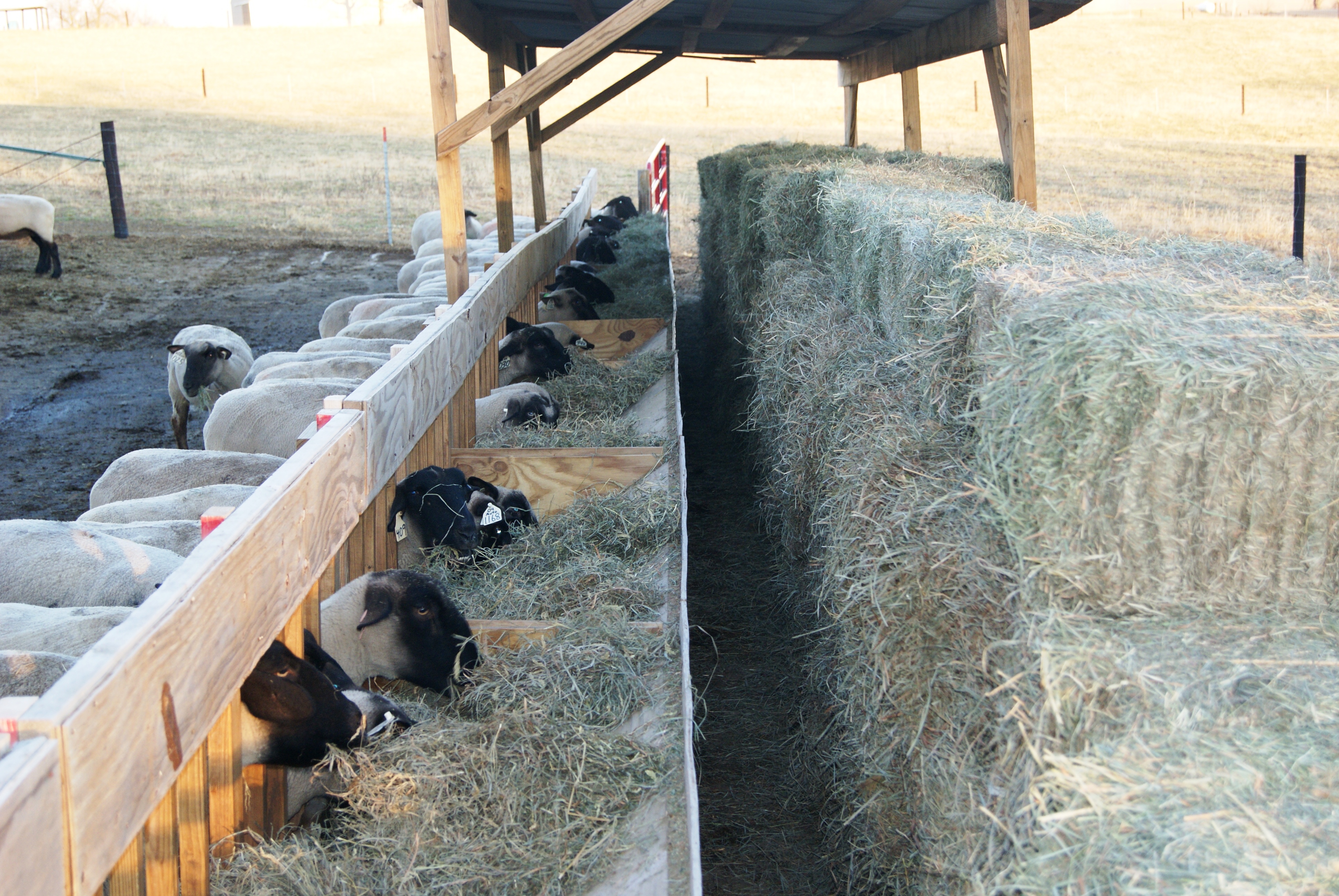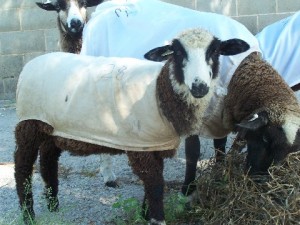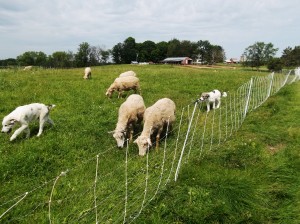Parasites are largely thought of as a limiting factor in sheep production, especially on pasture. According to the SID Sheep Production Handbook, larval development on pasture and the subsequent ingestion of the infective larval by sheep is affected by many factors, especially temperature and moisture.
Because sheep are managed under various conditions, regional differences occur in the development of parasites, and subsequent prevention and control strategies used. Producers should have a good working knowledge of parasite biology and how these regional differences affect the development of disease in order to design a practical and effective control strategy.
Within regions, many shepherds specialize their flocks, concentrating on things like dairy production, organic meat and wool production or raising show sheep. Like regional differences, specialty sheep production also requires a unique understanding of parasite prevention and control.
Organic Flocks
Snoqualmie Valley Lamb® is a 100% grass-fed, U.S. Department of Agriculture-certified organic program that produces lamb at Aspen Hollow Sheep Station. Sustainably managed on 65 acres on the banks of the Snoqualmie River near Duvall, Wash., Aspen Hollow lambs spend their entire life on grass and in clover fields.
With a grass-based operation, parasites are constantly top-of-mind. While Jeff Rogers, station manager, explains he can’t prevent parasites in the flock, he can restrict the parasitic ability to persist and infect sheep to levels above what their immune system can fight off.
Rogers explains that in the Pacific Northwest, roundworms can be a problem when temperatures get above 70˚F – that is, when the sun is shining, which only happens a few months of the year. Otherwise, he says, “The gastro intestinal parasites I deal with are mostly small brown stomach and black scour worms. Our operating environment is a perfect incubator for parasites that thrive in cool, wet, cloudy conditions.”
External parasites are also a nuisance. Fly strike is managed by lambing in late spring before temperatures get above 70˚F. Additionally, the Yellow (Golden) Dung Fly is utilized because “they consume the larva of the black fly in the dung,” Rogers explains. Sheep can also get biting lice during the long, wet, sunless winters; shearing twice a year helps manage that issue. Also, a natural pyrethrum applied as a spray 10 days after shearing works well in disrupting the life cycle of the lice. Fleece is also important for managing parasites in the area, he says. “The wrong fleece type in a wet environment is a magnet for external parasites.” Finally, Rogers says overall animal health is important because, “any illness takes away from the animal’s ability to fight parasites with its own immune system.”

Aspen Hollow Sheep Station grazing rotation: On the right is a freshly mowed cell post 7 days grazing; on the left is where sheep were most recently grazing; and in the left background are the sheep in a fresh cell. Jeff Rogers, station manager, doesn’t let the sheep eat below four inches on the plant as part of his parasite management protocol.
Rogers manages forage through plant selection and raises lambs on pasture alone irrespective of parasites. “I don’t allow ewes or lambs to eat below four inches on the plant and I move fence daily,” he says of his intensive grazing system. Once a cell has been grazed down to four inches, he moves the sheep to a fresh cell. “About a week after taking the sheep off a cell, I go in with a mulching mower and cut the residue down a couple more inches,” Rogers goes on to say. “This process desiccates a large percentage on any infective larva remaining on the pasture, so when the sheep come back in 30 days, there is a fresh stand of highly digestible and parasitic-safe forage.” A higher rate of natural decimation of parasitic larva occurs on grass stems, Rogers explains. Grass that produces a long bridge from the base of the plant to the leaf is a safer plant to graze. Some grasses have very short stems, which provide a perfect environment for parasites.
Overall, parasite management is conducted at a low level at Aspen Hollow. Rogers runs fecal egg counts several times a year to look at the population numbers in the sheep. Through early selection of parasite resistance, lambs from the station’s own ewes and rams have a fairly high genetic resistance to internal parasites. “This doesn’t mean we don’t have parasites, it just means our management practices and genetic selection of sheep and forage are currently working well for us,” Rogers concludes.
Show Sheep
“Show sheep” can range from registered sheep to frame sheep to club lambs. According to Dr. Dan Morrical, Iowa State University Sheep Extension Specialist, most show sheep are confined and don’t have access to grass, so parasites often times don’t pose a threat.

According to Dr. Dan Morrical, Iowa State University Sheep Extension Specialist, parasites often times don’t pose a threat to sheep that are raised in a dry lot (like show sheep frequently are) and don’t have access to grass.
If show sheep are provided a small paddock where they have access to grass and weeds, parasites could become an issue. However, Dr. Morrical recommends knowing the signs of parasitism before “treating” it. “The biggest mistake people make is that anytime they have a thin sheep, they automatically think its parasites,” he says. This is a mistake because parasites are often a flock problem, not an individual problem, he explains.
Many shepherds understand the importance of deworming, but recent research contradicts the old school theory of rotating dewormers. “If you have a dewormer that works, use it until it doesn’t work anymore,” Dr. Morrical says, “because there aren’t any more new dewormers.” The four classes of dewormers for internal parasites are: 1) benzimidazoles (white), 2) levamisole (yellow), 3) macrocyclic lactones (clear) and 4) amino-acetonitrile derivative (orange). Using one dewormer can control parasites for four to six years, Dr. Morrical says.
As a preventive management practice, Dr. Morrical recommends deworming ewes for internal parasites twice a year: once before going to pasture and once either pre-breeding (roughly the middle of July) or in the jug after lambing. For external parasites, he recommends pouring ewes directly after shearing and again 21 days later to prevent the next generation of eggs from hatching.
If you think you have a sheep suffering from parasitism, individuals can be checked via an eyelid test for anemia. In Iowa, the biggest parasite issue producers deal with is the barber pole worm that sucks blood (thus creating anemia) and who, under a microscope, shows stripes from the blood that looks like an old-fashioned barber’s pole. Additionally, sheep with signs of bottle jaw need treated for parasites.
When treating for parasites, he recommends using a drench as opposed to an injectible dewormer. “The worms are in the gut,” Dr. Morrical explains. “Using a drench goes directly to the problem.” He also recommends holding sheep off feed for 12 hours after treatment because the dewormer will stay in the gut longer. If the parasite problem is extreme, he says to treat the animal with a drench dewormer, hold them off feed for 12 hours and then drench them again.
Still, he warns, even though you may drench sheep as a parasite preventive or treatment, the practice is only 95 to 99% efficient. There is a chance that if the ewes go back to pasture they can get worms again. It’s worth knowing parasite numbers peak in July and younger sheep aren’t as good at fighting off parasites as older sheep – another good reason to dry lot your ewe lambs.
Compared to show sheep producers, commercial sheep producers may take a more profit-oriented, targeted approach to parasite management, Dr. Morrical adds, by only deworming yearlings or on a case-by-case. “Purebred flocks tend to be smaller, so they may deworm the entire flock more often,” he says.
Concluding, Dr. Morrical comments that parasites are a world-wide problem, but don’t cost the industry as much as other diseases because people understand how important deworming is.
Fiber Flocks

Internal parasites can narrow fiber diameter, creating a weakness in the fleece, Dee Heinrich, Peeper Hollow Farm, says of her fiber flock.
Dee and Rick Heinrich of Peeper Hollow Farm raise dual-purpose sheep, namely Romney and Romeldale/CVM. Within a few years of starting their flock, Dee says, “I learned what made for “good fiber” and what hand spinners were looking for – I saw that as our niche.”
Marketing a niche product, the Heinrich’s work hard to manage their sheep properly and pay attention to parasites. “Our protocol depends very much on the weather and issues of that particular year,” Dee says of the often damp conditions in Marion, Iowa. “We don’t want to deworm more than necessary; we want to encourage parasite resistance.” Also, the couple needs to keep a healthy flock because parasitism can be reflected in the quality of fiber the sheep produce. “A parasite-ridden sheep will not produce high-quality fiber,” she explains. In order to produce fiber that is uniform along the staple, the nutritional needs of the sheep must be met consistently throughout the year. Internal parasites can narrow the fiber diameter, creating a weakness in the fleece. “We do everything we can to keep the parasite load our sheep carry low enough that it doesn’t impact their well-being or fiber production,” Dee explains.
Parasite management at Peeper Hollow starts with breeding for parasite resistant sheep; any ewes requiring deworming mid-year are culled. “They obviously can’t handle the parasite load as well as the others,” she explains. They also rotate pastures and put lambs in the pasture first because it has the lowest parasite load at that point. “When the lambs enter the pasture, the grazing is deep,” Dee says. “Since parasites tend to live in the bottom 2 to 3 inches of grass, it reduces the parasites our lambs are exposed to.” After the lambs are moved from the pasture, the ewes follow because they can better tolerate a heavier parasite load. “In most cases, the ewes are resistant to internal parasites by the age of two,” Dee says. The sheep are out to pasture for about six days, and then are moved to a new paddock.
During lambing, they deworm ewes while in the lambing jugs. Lambs are dewormed at weaning – about 60 days of age. “After that,” Dee says, “they’re dewormed only as needed individually.” Dee and Rick look for things like poor gain or scouring to determine if they need to deworm an individual. “If we see a particular lamb being dewormed more often than the rest, that lamb doesn’t make the breeding stock cut,” Dee explains. The couple strongly believes sheep producers need to keep working towards resistance against internal parasites, “so we need to only keep those lambs who can, for the most part, deal with parasites on their own,” she says.
When bringing in new sheep, Peeper Hollow deworms the individual until they test “clear” for parasites “so we don’t inherit the resistant parasites from other farms,” she explains. “We know this won’t clear them up completely, but if they test “clear” we expect the eggs in their droppings will be very few when compared against the rest being dumped into a field by our own sheep.”
Finally, Peeper Hollow Farm doesn’t make a practice of showing their sheep, which virtually eliminates external parasite issues that come from exposure.
Dairy Sheep
In a world where dairy and organic production coincide, Dave and Mary Falk of LoveTree Farmstead Cheese own an operation that thrives on minimal inputs – including a parasite management program that hasn’t used chemical dewormers in more than 20 years.

Mary Falk credits her Spanish Ranch Mastiff X Maremma-Tatra guard dogs to the overall success of the LoveTree Farmstead organic dairy and largely parasite-free operation.
LoveTree, established in 1986, resides in the Trade Lake region of northern Wisconsin. “This region has a very tight window of opportunity for raising grain crops, but grasses grow here abundantly and easily,” Mary says. “It’s a perfect match for dairy sheep production.” The farm includes 200 acres – about half of which is devoted to wildlife habitat. Given the environment, the Falk’s “firmly believe the only way a dairy sheep farmer will economically survive the harsh climate of this region is to raise a tough, naturally hardy sheep that can thrive on a grass-based program while producing high butterfat milk,” Mary explains.
To accomplish their goals, the LoveTree team does things a little differently: they free-graze the fields that need it the most starting with the lactating ewes and then bring in the lambs to graze the lower part of the plant. They feel this strategy, that lets lactating ewes – which have higher nutritional requirements due to milk production – graze lush grass lightly, helps them manage parasites, especially, Mary says, since most of their sheep are immune to parasites by a year of age.
Until they’re old enough, though, lambs—especially keeper ewe lambs – are monitored closely. The Falk’s like to let the ewe lambs age by starting them in a dry lot on grass hay, and then turning them out to grass and watching them closely. “We want to get some age on them without setting them back,” she explains. “A lot of the success in building parasite immunity is simply not exposing them.”
Because barber pole worms and liver flukes are the most destructive parasites in the area, deworming is occasionally done on an as-needed basis whenever signs of anemia, bottle jaw, poor body condition or scours appear.
Genetic selection against parasites, Mary feels, only works to a point in the immediate area, though she certainly credits their closed flock to minimal parasite issues over the years.
Different from a conventional dairy that weans lambs shortly after birth and raises them artificially, the LoveTree weans lambs at 30 to 45 days. That way, Mary says, the lambs go out on grass with their mothers at a young age and learn how to graze before being weaned and dry lotted for a period of time. Also different from conventional dairy’s, which Mary says often times concentrates sheep and grain feeds them in order to increase milk production,
Though there are many differences between flocks and sheep producers, parasite management is a one thing all shepherds have in common.


